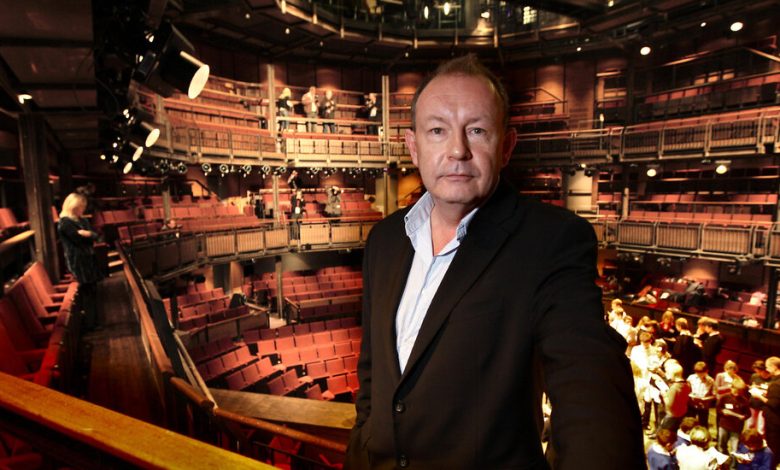Michael Boyd, Who Invigorated the Royal Shakespeare Company, Dies at 68

Michael Boyd, who led the Royal Shakespeare Company as artistic director from 2002 to 2012, a decade in which he stabilized the organization while undertaking ambitious projects including a heralded New York residency and the mounting of the un-Shakespearean hit show “Matilda the Musical,” died on Thursday at his home in London. He was 68.
His family, in a statement posted on the Royal Shakespeare Company’s website, said the cause was cancer.
Mr. Boyd had a distinguished career as a director stretching back to the early 1980s, when he was with the Belgrade Theater in Coventry, England. Work he directed there and in a subsequent stop at the Tron in Glasgow — a gritty urban musical called “Risky City,” a reimagined “Macbeth,” an adaptation of Janice Galloway’s novel “The Trick Is to Keep Breathing” and more — caught the attention of playgoers and critics.
And in 1996 it earned him an appointment as an associate director of the Royal Shakespeare Company, where he continued to direct well-regarded productions and, in 2002, stepped up to artistic director.
He took the job at a time when that venerable company was facing challenges and criticism, including over its recent decision to vacate its longtime home, the Barbican Center in London, and scale back its ensemble work. Michael Billington, a theater critic for The Guardian, had criticized the outgoing director, Adrian Noble, for “attempting to create a revolution within the R.S.C. culture without getting the approval of the theater profession or the public.”
Mr. Boyd, during his decade at the helm, brought audiences back; oversaw the renovation of the company’s theater complex at Stratford-upon-Avon; created a reproduction of its classical theater in the Park Avenue Armory in Manhattan for a five-play residency in 2011; and set in motion the World Shakespeare Festival of 2012, a multicity celebration involving more than 50 arts organizations.
Mr. Boyd, The Guardian said in summarizing his decade of leadership, presided “over a spectacular financial and architectural turnaround.”
In announcing in 2011 that he was stepping away, he said the job had begun to wear on him.
“I’ve always said it would take 10 years to do something significant towards the life and the spirit of the company,” he told The Birmingham Evening Mail, “though more than 10 years would potentially not be so good for the life and the spirit of the artistic director.”
But Mr. Boyd was hardly done. He continued to direct notable productions, including “Tamburlaine, Parts I and II,” the Christopher Marlowe classic, for Theater for a New Audience in New York in 2014. It’s a bloody tale from 1587 about the warrior Tamburlaine, and Mr. Boyd didn’t hold back; the show used 144 gallons of stage blood a week. For one effect, blood was pumped from beneath the stage so that it would creep up the skirt of a particular character.
“We’ve designed a costume that’s very absorbent,” Mr. Boyd told The New York Times.
Ben Brantley, reviewing the show for The Times, said that “Mr. Boyd manages to balance the distancing effects of a Brechtian epic with the rock ’em-sock ’em thrills of a Michael Bay action flick.”
Mr. Boyd’s relationship with Theater for a New Audience went back years. Jeffrey Horowitz, the company’s founding artistic director, noted that in 2007 Mr. Boyd had invited the group to bring its “Macbeth” to Royal Shakespeare’s Complete Works Festival, at which all of Shakespeare’s works were presented at Stratford-upon-Avon.
“Michael Boyd’s generosity had a huge impact on T.F.A.N.A.,” Mr. Horowitz said by email. As for “Tamburlaine,” the 2014 production, he said, “Michael created an extraordinary sense of community in the acting company, instilling a passion for discovering and communicating what was living in Marlowe’s text now rather than being didactic about meaning.”
John Michael Boyd was born on July 6, 1955, in Belfast, Northern Ireland. His father, John, was a doctor, and his mother, Sheila (Small) Boyd, taught art. Michael was raised in London, but when he was a teenager the family moved to Edinburgh, where the vibrant theater and festival scene grabbed him.
“It was massively overwhelming,” he told The Daily Telegraph of Britain in 2002, “a crash course in all the different things that theater could be.”
After earning a degree in English at the University of Edinburgh, Mr. Boyd won a fellowship to spend a year studying theater in Moscow under Anatoly V. Efros, a leading Soviet director.
“What I loved about Efros,” he told The Telegraph, “was his combination of bold visual flair with a complex understanding of humanity” — attributes that described much of Mr. Boyd’s work in the ensuing years.
Some of his earliest directorial work was at the theater in Coventry, a fast-paced, adventurous house.
“It was a mad time,” he told The Coventry Evening Telegraph in 2002. “I remember doing 10 productions in one year, but it was also a very fruitful time for me.”
By 1986 he was at the Tron, another buzzing theater. For his “Macbeth” there in 1993, he surprised audiences right from the start, opening not with the usual witches’ prologue but with three cellists playing a dirge while corpses were stacked in an open grave.
“It is a brilliant opening which demands an immediate reorientation of the responses of the audience,” John Linklater wrote in a review in The Herald of Glasgow. “The physical and moral geography of the play is drastically rearranged.”
Just before he was named artistic director at the Royal Shakespeare Company, which was founded in 1961 by the director Peter Hall, Mr. Boyd won an Olivier Award, the British version of the Tony, for directing the company’s history play cycle, “Henry VI, Parts 1, 2, and 3” and “Richard III.”
His marriage to Marcella Evaristi in 1982 ended in divorce. He and Caroline Hall, who had been his partner since 1991, married in 2004. She survives him, along with a daughter from their marriage, Rachael; two children from his first marriage, Daniel and Gabriella; a sister, Susan; and a grandson.
One of Mr. Boyd’s bolder moves during his decade as artistic director was overseeing “Matilda the Musical,” a treatment of the Roald Dahl story.
The company had long been buoyed by revenue from “Les Misérables,” which it had produced in the 1980s and which ran on Broadway for 16 years in its initial incarnation, but Mr. Boyd knew that a fresh income stream from a popular show was needed. His gamble on “Matilda” paid off: It was a hit in England in 2010 and later ran for almost four years on Broadway.
Mr. Brantley, reviewing the Broadway opening for The Times, called it “the most satisfying and subversive musical ever to come out of Britain.”




